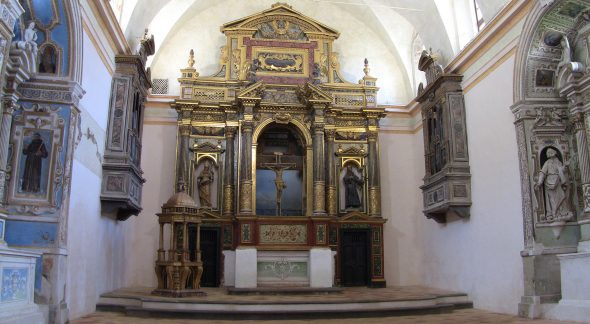La Chiesa di Santa Maria Nuova di Gubbio presenta quel caratteristico stile dell’architettura cistercense prevalente negli edifici ecclesiastici dell’eugubino del XIII secolo. L’edificio si erge all’interno del quartiere Sant’Andrea, nel quadrante sud-est della città.
Particolare e suggestiva è la forma asimmetrica della facciata: troviamo infatti il portone situato nella parte sinistra, mentre il rosone è collocato in alto sulla destra della facciata. Nel complesso, facciata è semplice ma particolarmente elegante.
![]()
Purtroppo il bianco che pervade l’interno fu venne aggiunto nel corso del XVII secolo, andando a coprire e quindi ad alterare quasi del tutto la decorazione pittorica originale. Restituisce comunque all’edificio un’atmosfera di grande sacralità ed estrema intimità.
Nel corso dei secoli, diversi affreschi sono riusciti a tornare visibili grazie a delicati lavori di recupero. Sulla parete destra, si trova un affresco chiamato “La Madonna del belvedere“ risalente al 1413 e realizzato da Ottaviano Nelli. L’artista completò l’opera dopo aver raggiunto una certa maturità tecnica e costruttiva che gli permise di portare avanti imprese pittoriche impegnative e di raggiungere una definitiva individualità di stile, il che lo consacrò come più il grande esponente della scuola eugubina e tra i migliori artista di Umbria e Marche nella prima metà del XV secolo.
Sulla parete sinistra si trova un immagine di S.Antonio Abbate del Palmerucci (XIV sec.). Guido Palmerucci è considerato anch’egli tra i migliori pittori Umbro del suo tempo e a lui sono attribuite varie opere preziose.
![]()
The Church of Santa Maria Nuova has the characteristic style of the cistercense architecture prevailing in the ecclesiastical buildings of XIII century Gubbio.
The facade is simple, but particularly elegant. At the inside of the church, on the skillful wall, lies a fresco called “La Madonna del belvedere” from 1413, realized by Ottaviano Nelli. He realized it after having achieved a technical and constructive maturity which allowed him to perform delightful works and to develop a definitive individuality of style. This has consecrated him as the exponent of the Gubbio school and the best artist in Umbria and Marche of first half of XV century. On the left wall an image of S.Antonio Abbate of the Palmerucci is found (XIV century). Guido Palmerucci is considered the best painter from Umbria of his period: to him several remerkable works are attributed.
The Church of Santa Maria Nuova has the characteristic style of the cistercense architecture prevailing in the ecclesiastical buildings of XIII century Gubbio.
The facade is simple, but particularly elegant. At the inside of the church, on the skillful wall, lies a fresco called “La Madonna del belvedere” from 1413, realized by Ottaviano Nelli. He realized it after having achieved a technical and constructive maturity which allowed him to perform delightful works and to develop a definitive individuality of style. This has consecrated him as the exponent of the Gubbio school and the best artist in Umbria and Marche of first half of XV century. On the left wall an image of S.Antonio Abbate of the Palmerucci is found (XIV century). Guido Palmerucci is considered the best painter from Umbria of his period: to him several remerkable works are attributed.
The Church of Santa Maria Nuova has the characteristic style of the cistercense architecture prevailing in the ecclesiastical buildings of XIII century Gubbio.
The facade is simple, but particularly elegant. At the inside of the church, on the skillful wall, lies a fresco called “La Madonna del belvedere” from 1413, realized by Ottaviano Nelli. He realized it after having achieved a technical and constructive maturity which allowed him to perform delightful works and to develop a definitive individuality of style. This has consecrated him as the exponent of the Gubbio school and the best artist in Umbria and Marche of first half of XV century. On the left wall an image of S.Antonio Abbate of the Palmerucci is found (XIV century). Guido Palmerucci is considered the best painter from Umbria of his period: to him several remerkable works are attributed.
The Church of Santa Maria Nuova has the characteristic style of the cistercense architecture prevailing in the ecclesiastical buildings of XIII century Gubbio.
The facade is simple, but particularly elegant. At the inside of the church, on the skillful wall, lies a fresco called “La Madonna del belvedere” from 1413, realized by Ottaviano Nelli. He realized it after having achieved a technical and constructive maturity which allowed him to perform delightful works and to develop a definitive individuality of style. This has consecrated him as the exponent of the Gubbio school and the best artist in Umbria and Marche of first half of XV century. On the left wall an image of S.Antonio Abbate of the Palmerucci is found (XIV century). Guido Palmerucci is considered the best painter from Umbria of his period: to him several remerkable works are attributed.



Comment (0)